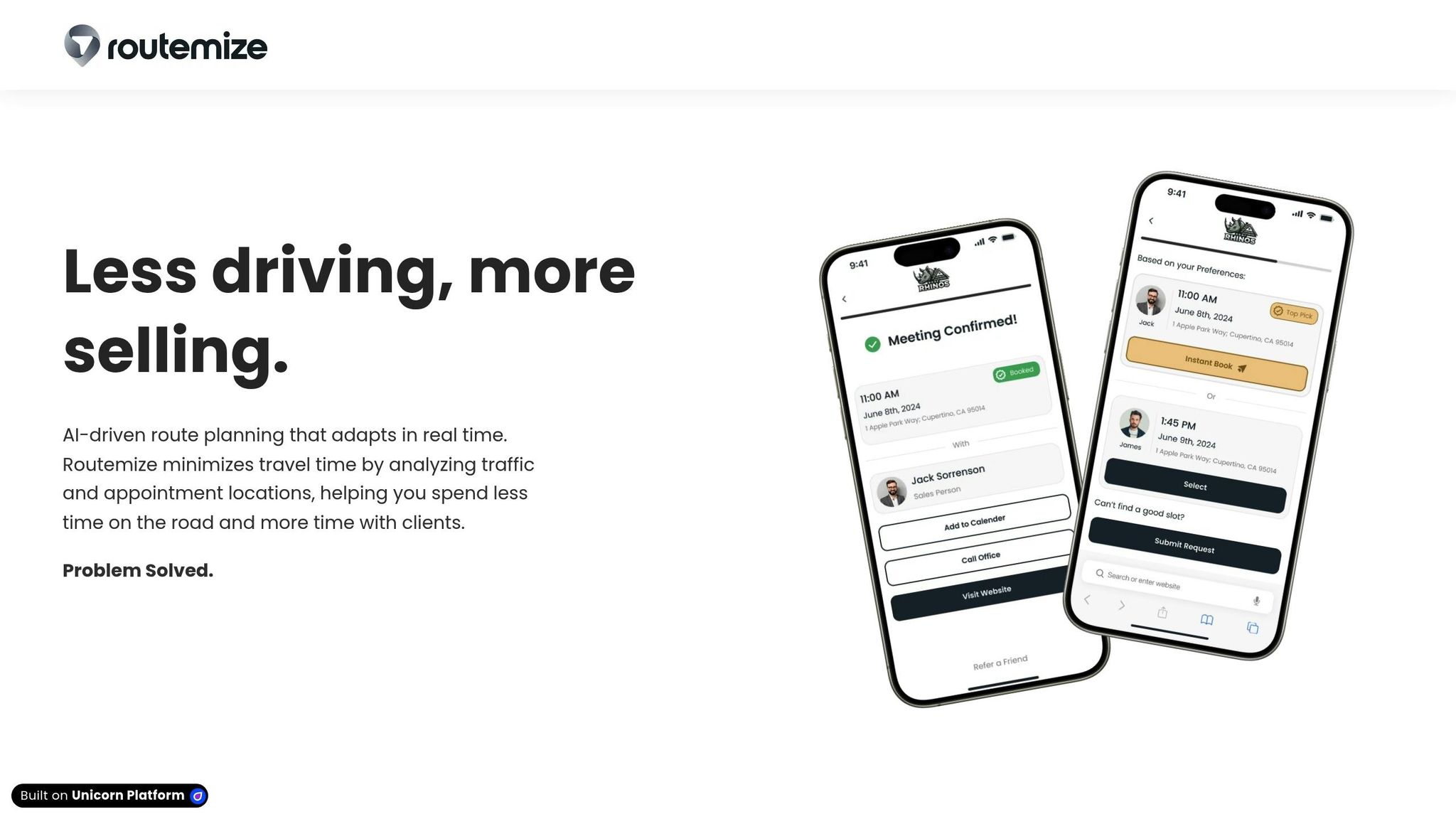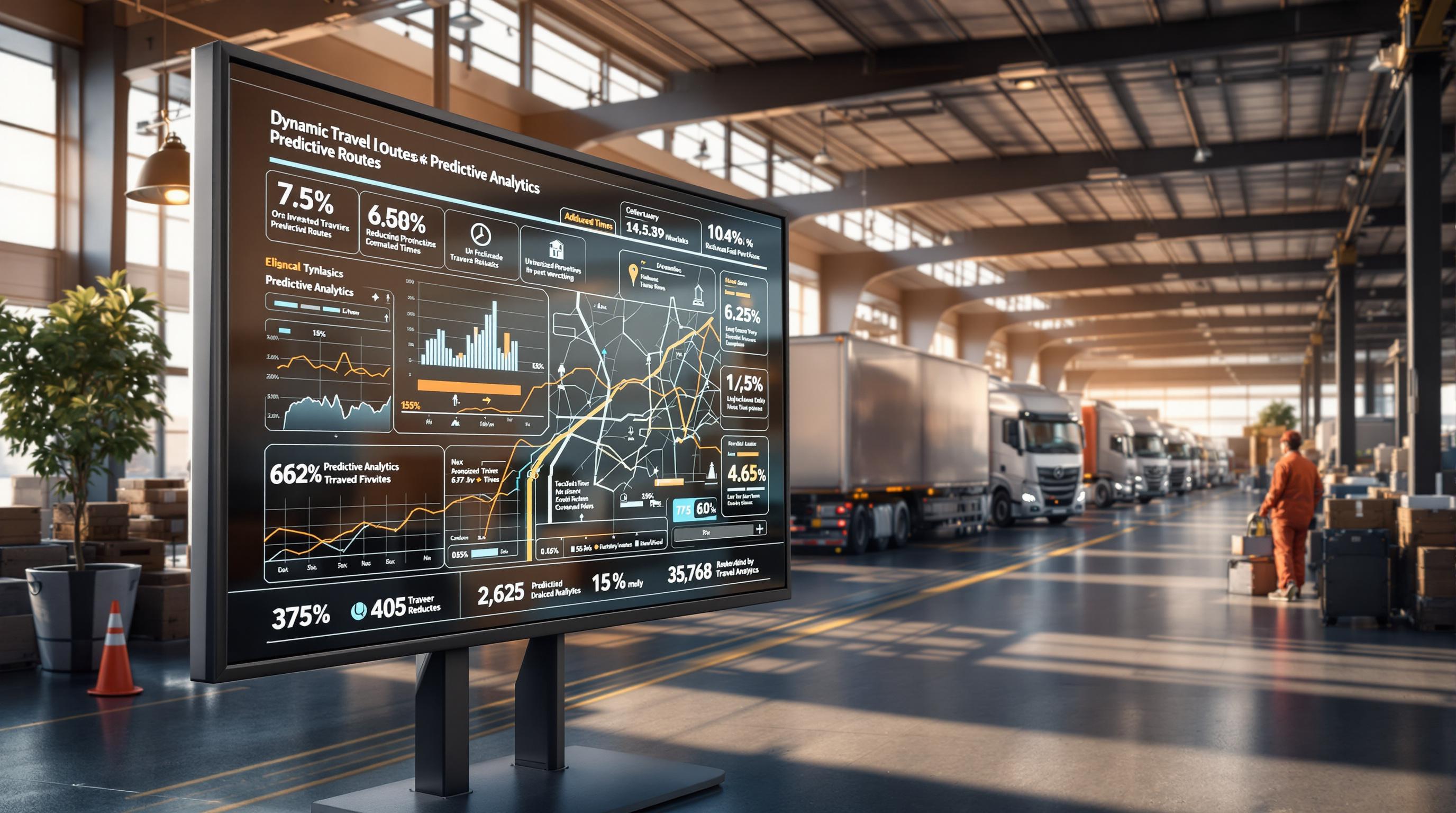AI helps businesses predict and avoid delivery delays by analyzing real-time data like traffic, weather, and past delivery performance. Tools like Routemize optimize delivery routes dynamically, improving efficiency and customer satisfaction. Here's how AI works:
- Traffic Data: Uses GPS, traffic sensors, and road updates to estimate delivery times.
- Weather Data: Considers rain, snow, and other conditions to adjust routes.
- Historical Data: Analyzes past deliveries to identify patterns and refine predictions.
- Machine Learning Models: Neural networks, random forests, and gradient boosting improve accuracy.
Using AI and data for predictive planning and supply chain
Data Types Used in AI Predictions
Modern AI systems use a variety of data sources to predict delivery delays with precision. Each type of data plays a specific role in improving the accuracy of these predictions.
Traffic Data Analysis
AI platforms examine both real-time and historical traffic data to estimate delivery times more effectively. Key sources include:
- GPS systems tracking vehicle speed and locations
- Traffic sensors from transportation agencies measuring flow
- Mobile data providing insight into current road conditions
- City databases with updates on construction and road closures
Tools like Routemize adjust routes dynamically, helping drivers steer clear of unexpected congestion.
Weather Impact Analysis
Weather conditions can significantly affect delivery times. AI systems gather data from sources like the National Weather Service, local stations, satellite imagery, and road condition sensors. They evaluate factors such as heavy rain, snow, ice, strong winds, and extreme temperatures. This information helps adjust arrival time estimates and reroute deliveries to avoid weather-related disruptions.
Past Delivery Performance
Historical data is crucial for refining AI prediction models. By analyzing past deliveries, businesses can identify patterns like seasonal fluctuations, location-specific challenges, peak traffic times, and variations in driver performance. To make this work, companies need detailed records, including:
- Actual delivery times
- Route specifics
- Vehicle information
- Driver feedback
- Accurate customer timestamps
This kind of analysis helps improve scheduling and routing, ensuring smoother operations.
AI Methods for Delay Prediction
AI systems analyze delivery data to forecast delays, using a mix of techniques to create models that improve logistics efficiency.
Types of Machine Learning Models
Delivery prediction relies on several machine learning models to assess potential delays:
- Neural Networks: Detect complex patterns from factors like traffic, weather, and historical data.
- Random Forests: Examine multiple decision paths to pinpoint likely delay scenarios.
- Gradient Boosting: Improve accuracy by learning from past prediction errors.
For instance, some advanced solutions combine real-time traffic updates with historical trends to dynamically adjust delivery routes. These models, paired with time-based analysis, offer even more precise delay predictions.
Time-Based Prediction Methods
Time-based analysis identifies how different time scales influence delivery performance by examining specific patterns:
| Time Scale | Focus | Key Indicators |
|---|---|---|
| Hourly | Peak traffic times | Rush hours, local events |
| Daily | Day-specific trends | Weekday vs. weekend differences |
| Seasonal | Long-term patterns | Weather, holidays |
| Annual | Yearly trends | Major events, business cycles |
By combining these temporal patterns with real-time data, AI systems can predict slowdowns, such as school dismissals or tourist traffic. However, the success of these methods depends on having a robust dataset of historical delivery information to establish reliable trends.
When delays are detected, AI systems can take action by:
- Re-routing deliveries to avoid congestion.
- Rescheduling deliveries to better align with updated conditions.
- Notifying customers with revised arrival times.
- Recommending optimal delivery windows to reduce future delays.
sbb-itb-7020db0
AI Tools in Action
AI tools have advanced beyond predictive analytics to enable real-time route adjustments. Modern platforms now process live data to fine-tune delivery routes and schedules, making delivery management faster and more efficient.
Routemize: Smarter Route Planning

Routemize is a standout example of AI-powered route optimization. Its strength lies in analyzing live traffic data alongside appointment locations, helping delivery teams cut down on travel time by recalculating routes on the go.
Here’s what Routemize brings to the table:
| Feature | Function | Advantage |
|---|---|---|
| Real-time Analysis | Tracks live traffic updates | Avoids delays with instant route changes |
| Location Optimization | Plans stops strategically | Cuts down travel time between deliveries |
| Dynamic Routing | Adjusts routes automatically based on conditions | Boosts delivery efficiency |
| Client-focused Scheduling | Times appointments with traffic data in mind | Improves punctuality for deliveries |
Currently in beta, Routemize allows businesses to explore AI-driven route management without upfront costs, making it a low-risk option for companies looking to modernize their logistics.
Real-World Impact of AI in Delivery
Routemize’s real-time adaptability tackles common delivery challenges head-on. By analyzing traffic and optimizing stop locations, it shows how AI can solve everyday logistical problems effectively.
This approach mirrors a growing industry trend of leveraging AI for:
- Predictive Insights: Spotting potential delays before they happen
- Dynamic Scheduling: Adjusting delivery times based on live conditions
- Resource Efficiency: Streamlining operations through smarter routing
As AI tools grow more sophisticated, integrating them into logistics systems is becoming essential for businesses aiming to stay competitive. The real game-changer? Choosing platforms with strong real-time analysis and seamless integration capabilities.
Common Issues and Solutions
Smooth data flow between existing systems and new AI tools is crucial for accurate AI-driven delivery predictions. Let’s look at some common challenges and how to tackle them effectively.
Data System Integration
Integration challenges often fall into three categories, each requiring specific approaches:
- Legacy System Compatibility: Use standardized API protocols to ensure systems can exchange data without hiccups.
- Data Format Inconsistencies: Automated tools can help align and harmonize data formats from different sources.
- Real-Time Data Access: Edge computing is a practical solution for ensuring low-latency updates.
To overcome these hurdles, build strong data pipelines that connect systems like warehouse management, GPS tracking, and AI prediction platforms. Standardizing data formats and keeping a close eye on system performance can help you quickly resolve any bottlenecks.
Once integration is solid, the next step is improving the accuracy of delivery predictions.
Improving Prediction Quality
AI predictions are only as good as the data and training behind them. Here’s how to ensure your predictions are as reliable as possible:
-
Data Validation:
- Clean and verify historical delivery and GPS data to fix inaccuracies.
- Compare GPS coordinates with trusted reference points.
- Cross-check weather data from multiple sources for consistency.
-
Model Training:
- Regularly update AI models with new data.
- Incorporate seasonal trends and local factors into training.
- Fine-tune parameters based on actual performance metrics.
-
Monitoring:
- Continuously track predicted vs. actual delivery times.
- Study deviations and adjust prediction parameters as needed.
AI in Delivery Management
AI is reshaping delivery management by using real-time data and machine learning to predict and address delays effectively.
Key Advantages
- Better Delivery Timing: AI provides accurate, real-time estimates to streamline delivery schedules.
- Dynamic Route Planning: Tools like Routemize adjust routes on the go to avoid traffic and save time.
These advancements highlight how AI is changing last-mile delivery and paving the way for future progress in the field.
As technology advances, we can anticipate even more precise predictions to tackle last-mile obstacles.


